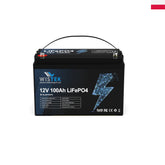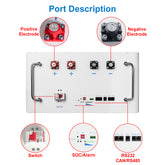Die optimale Verwendung einer 60-V-Lithiumbatterie – Spannungsdiagramm
60-V-Lithiumbatterien werden heutzutage in zahlreichen Anwendungen eingesetzt, darunter Elektrofahrzeuge, Elektrowerkzeuge und erneuerbare Energiesysteme. Das Wissen, wie man ein Spannungsdiagramm für 60-V-Lithiumbatterien effektiv nutzt, ist entscheidend für die Erhaltung der Batteriegesundheit und optimale Leistung. Dieser umfassende Leitfaden erläutert die Bedeutung von Spannungsdiagrammen, deren Interpretation und bewährte Verfahren zum Laden und Entladen Ihrer 60-V-Lithiumbatterie.
- Was ist ein Spannungsdiagramm für eine 60-V-Lithiumbatterie?
- So interpretieren Sie ein Spannungsdiagramm für eine 60-V-Lithiumbatterie
- Bedeutung der Verwendung eines Spannungsdiagramms für 60-V-Lithiumbatterien
- Bewährte Vorgehensweisen zum Laden und Entladen von 60-V-Lithiumbatterien
- Temperatureffekte auf die Leistung von 60-V-Lithiumbatterien
- Häufige Fehler, die Sie vermeiden sollten
Was ist ein Spannungsdiagramm für eine 60-V-Lithiumbatterie?
Ein Spannungsdiagramm für 60-V-Lithiumbatterien ist ein Tool, das die Spannungswerte der Batterie mit ihrem Ladezustand (SoC) korreliert. Da Lithiumbatterien beim Entladen keinen linearen Spannungsabfall aufweisen, liefern diese Diagramme eine genauere Darstellung der verbleibenden Kapazität. Anhand des Diagramms können Benutzer den ungefähren Ladezustand anhand der aktuellen Spannung bestimmen und so die Batterieverwaltung optimieren.
>>Siehe auch: Wie viel kostet es, Lithiumbatterien in einen Golfwagen einzubauen?
So interpretieren Sie ein Spannungsdiagramm für eine 60-V-Lithiumbatterie
Um ein Spannungsdiagramm für 60-V-Lithiumbatterien zu interpretieren, müssen Sie die gemessene Spannung Ihrer Batterie mit den im Diagramm aufgeführten Werten vergleichen. Wenn die Spannung Ihrer Batterie beispielsweise 64,5 V beträgt, können Sie anhand des Diagramms feststellen, dass der Ladezustand bei etwa 86 % liegt.
Schritte zum Interpretieren des Diagramms:
1. Messen Sie die Batteriespannung : Verwenden Sie ein zuverlässiges Voltmeter, um die aktuelle Spannung Ihrer Batterie zu messen.
2. Spannungsdiagramm zu Rate ziehen : Suchen Sie im Diagramm nach der gemessenen Spannung, um den entsprechenden Ladezustand in Prozent zu ermitteln.
3. Bewerten Sie den Batteriezustand : Durch regelmäßiges Überwachen der Spannung und Vergleichen mit dem Diagramm können Sie potenzielle Probleme mit dem Batteriezustand erkennen.
Bedeutung der Verwendung eines Spannungsdiagramms für 60-V-Lithiumbatterien
Die Verwendung einer Spannungstabelle für 60-V-Lithiumbatterien bietet mehrere Vorteile:
Genaue Ladezustandsschätzung : Bietet eine präzise Schätzung der verbleibenden Kapazität der Batterie und gewährleistet so ein rechtzeitiges Aufladen.
Verhindert Tiefentladung : Hilft, eine Entladung der Batterie unter ein sicheres Spannungsniveau zu vermeiden, was die Lebensdauer der Batterie verlängern kann.
Optimiert Ladezyklen : Durch das Verständnis des Ladezustands der Batterie können Benutzer die Ladezyklen optimieren und so die Gesamtleistung der Batterie verbessern.
Bewährte Vorgehensweisen zum Laden und Entladen von 60-V-Lithiumbatterien
Um die Lebensdauer und Effizienz Ihrer 60-V-Lithiumbatterie zu maximieren, beachten Sie die folgenden bewährten Vorgehensweisen:
Ladetipps:
Überladung vermeiden : Überschreiten Sie nicht die empfohlenen Spannungswerte, um eine Beschädigung der Batterie zu vermeiden.
Verwenden Sie kompatible Ladegeräte : Verwenden Sie immer Ladegeräte, die mit den Spezifikationen Ihres Akkus kompatibel sind, um ein sicheres Laden zu gewährleisten.
Laden Sie in einer sicheren Umgebung : Laden Sie den Akku in einem gut belüfteten Bereich und fern von brennbaren Materialien.
Tipps zum Entladen:
Tiefentladung vermeiden : Entladen Sie die Batterie nicht unter die empfohlene Spannung, um einen Kapazitätsverlust zu vermeiden.
Regelmäßige Verwendung : Verwenden und laden Sie den Akku regelmäßig auf, um seine Funktionsfähigkeit und Leistung zu erhalten.
Temperatureffekte auf die Leistung von 60-V-Lithiumbatterien
Die Temperatur spielt eine wichtige Rolle für die Leistung von Lithiumbatterien. Extreme Temperaturen können die Effizienz und Lebensdauer der Batterie beeinträchtigen.
Auswirkungen der Temperatur:
Hohe Temperaturen : Können die Selbstentladungsrate erhöhen und zu Überhitzung führen.
Niedrige Temperaturen : Können die Kapazität und Effizienz der Batterie verringern.
Empfohlene Temperaturbereiche:
Optimale Ladetemperatur : 20 °C bis 25 °C (68 °F bis 77 °F).
Optimale Betriebstemperatur : 10 °C bis 30 °C (50 °F bis 86 °F).
Durch die Aufrechterhaltung dieser Temperaturbereiche können Sie optimale Leistung und Langlebigkeit der Batterie gewährleisten.
>>Siehe auch: Lohnen sich Doppelbatterien für Ihr Fahrzeug wirklich?
Häufige Fehler, die Sie vermeiden sollten
So gewährleisten Sie die Langlebigkeit und Effizienz Ihrer 60-V-Lithiumbatterie:
Überladung vermeiden : Ständiges Laden der Batterie über ihre volle Ladespannung hinaus kann ihre Lebensdauer verkürzen.
Vernachlässigung der Spannungsüberwachung : Wenn die Batteriespannung nicht überwacht wird, kann es zu Tiefentladungen und damit zu irreversiblen Schäden kommen.
Verwendung inkompatibler Ladegeräte : Die Verwendung von Ladegeräten, die nicht für Ihren speziellen Akku ausgelegt sind, kann zu unsachgemäßem Laden und potenziellen Gefahren führen.
Die optimale Anwendung einer 60-V-Lithiumbatterie-Spannungstabelle ist entscheidend für die Erhaltung der Batteriegesundheit und optimale Leistung. Durch die genaue Interpretation der Spannungswerte und die Einhaltung bewährter Lade- und Entladeverfahren können Anwender die Lebensdauer ihrer 60-V-Lithiumbatterien deutlich verlängern. Regelmäßige Überwachung und richtige Pflege sind entscheidend, um den Nutzen dieser leistungsstarken Energiequellen zu maximieren.
Zusammenfassend lässt sich sagen, dass ein Spannungsdiagramm für 60-V-Lithiumbatterien ein wertvolles Hilfsmittel ist, um den Ladezustand ihrer Batterien genau zu beurteilen. Durch die Integration dieser Vorgehensweise in regelmäßige Wartungsroutinen können Benutzer die Langlebigkeit und Effizienz ihrer 60-V-Lithiumbatterien sicherstellen.



















Leave a comment
All blog comments are checked prior to publishing